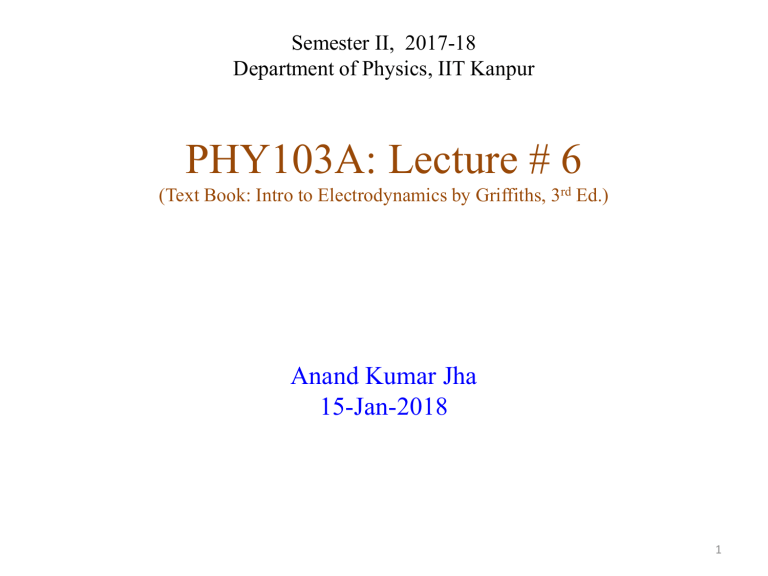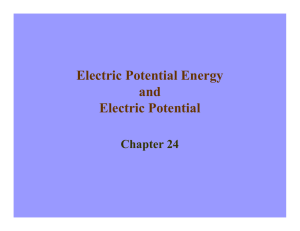
Semester II, 2017-18 Department of Physics, IIT Kanpur PHY103A: Lecture # 6 (Text Book: Intro to Electrodynamics by Griffiths, 3rd Ed.) Anand Kumar Jha 15-Jan-2018 1 Summary of Lecture # 5: • Gauss’s Law from Coulomb’s Law: 𝛁𝛁 ⋅ 𝐄𝐄 = • Curl of the electric field : 𝛁𝛁 × 𝐄𝐄 = 0 • Electric Potential: 𝐄𝐄 = −𝛁𝛁V 𝜌𝜌 𝜖𝜖0 𝒃𝒃 V 𝐛𝐛 − V(𝐚𝐚) = − � 𝐄𝐄 ⋅ 𝑑𝑑𝐥𝐥 𝐫𝐫 V 𝐫𝐫 = − � 𝐄𝐄 ⋅ 𝑑𝑑𝐥𝐥 𝒂𝒂 ∞ • Electric Potential due to a localized charge distribution 𝑞𝑞 1 V 𝐫𝐫 = 4𝜋𝜋𝜖𝜖0 r Point charge 1 𝑑𝑑𝑑𝑑 V(𝐫𝐫) = � 4𝜋𝜋𝜖𝜖0 r Charge distribution 2 Charge distribution in terms of electric potential: Gauss’s Law 𝛁𝛁 ⋅ 𝐄𝐄 = 𝜌𝜌 𝜖𝜖0 But 𝛁𝛁 × 𝐄𝐄 = 0 ⇒ 𝐄𝐄 = −𝛁𝛁V Therefore, 𝛁𝛁 ⋅ 𝐄𝐄 = 𝛁𝛁 ⋅ −𝛁𝛁V = −𝛁𝛁 ⋅ 𝛁𝛁V = −𝛻𝛻 2 V = 𝛻𝛻 2 V 𝜌𝜌 =− 𝜖𝜖0 Poisson’s Equation 𝜌𝜌 𝜖𝜖0 In the region of space where there is no charge, 𝜌𝜌=0 𝛻𝛻 2 V = 0 Laplace’s Equation 3 Summary: 𝜌𝜌 V 𝐄𝐄 = −𝛁𝛁V 𝐫𝐫 V 𝐫𝐫 = − � 𝐄𝐄 ⋅ 𝑑𝑑𝐥𝐥 ∞ Electrostatics 𝐄𝐄 4 Work and Energy in Electrostatics There is a charge 𝑄𝑄 in an electrostatic field 𝐄𝐄. How much work needs to be done in order to move the charge from point 𝒂𝒂 to 𝒃𝒃? 𝒃𝒃 𝒃𝒃 𝑊𝑊 = � 𝐅𝐅 ⋅ 𝑑𝑑𝐥𝐥 = −𝑄𝑄 � 𝐄𝐄 ⋅ 𝑑𝑑𝐥𝐥 = Q V 𝐛𝐛 − V(𝐚𝐚) 𝒂𝒂 𝒂𝒂 • 𝐅𝐅 = −𝑄𝑄𝐄𝐄 is the force one has to exert in order to counteract the electrostatic force 𝐅𝐅 = 𝑄𝑄𝐄𝐄. • Work done to move a unit charge from point 𝒂𝒂 to 𝒃𝒃 is the potential difference between points 𝒃𝒃 and 𝒂𝒂 • Work is independent of the path. Take V(𝐚𝐚)=V(∞)=0 and V 𝐛𝐛 = V 𝐫𝐫 𝑊𝑊 = QV 𝐫𝐫 If Q = 1, 𝑊𝑊 = V 𝐫𝐫 • Work done to construct a system of unit charge (to bring a unit charge from ∞ to 𝐫𝐫 is the electric potential. • Thus, electric potential is the potential energy per unit 5 charge Work required to assemble 𝒏𝒏 point charges: The work required to construct a system of one point charge 𝑄𝑄 is: 𝑊𝑊 = QV 𝐫𝐫 . Work required to bring in the charge 𝑞𝑞1 from ∞ to 𝐫𝐫𝟏𝟏 : 𝑊𝑊1 = 𝑞𝑞1 V0 = 𝑞𝑞1 × 0 = 0 Work required to bring in the charge 𝑞𝑞2 from ∞ to 𝐫𝐫𝟐𝟐 : 𝑊𝑊2 = 𝑞𝑞2 V1 = 𝑞𝑞2 1 𝑞𝑞1 4𝜋𝜋𝜖𝜖0 r12 Work required to bring in the charge 𝑞𝑞3 from ∞ to 𝐫𝐫𝟑𝟑 : 𝑊𝑊3 = 𝑞𝑞3 V2 = 𝑞𝑞 1 𝑞𝑞1 + 𝑞𝑞2 3 4𝜋𝜋𝜖𝜖 r r23 0 13 Total work required to bring in the first three charges: 𝑊𝑊 = 𝑊𝑊1 + 𝑊𝑊2 + 𝑊𝑊3 = 1 𝑞𝑞1 𝑞𝑞2 4𝜋𝜋𝜖𝜖0 r12 + 𝑞𝑞1 𝑞𝑞3 r13 + 𝑞𝑞2 𝑞𝑞3 r23 Total work required to bring in the first four charges: 𝑊𝑊 = 𝑊𝑊1 + 𝑊𝑊2 + 𝑊𝑊3 + W4 = 1 𝑞𝑞1 𝑞𝑞2 4𝜋𝜋𝜖𝜖0 r12 + 𝑞𝑞1 𝑞𝑞3 r13 + 𝑞𝑞2 𝑞𝑞3 r23 + 𝑞𝑞1 𝑞𝑞4 r14 + 𝑞𝑞2 𝑞𝑞4 r24 + 𝑞𝑞3 𝑞𝑞4 r34 6 Work required to assemble 𝒏𝒏 point charges: Total work required to bring in the first four charges: 𝑊𝑊 = 𝑊𝑊1 + 𝑊𝑊2 + 𝑊𝑊3 + W4 = 1 𝑞𝑞1 𝑞𝑞2 4𝜋𝜋𝜖𝜖0 r12 + 𝑞𝑞1 𝑞𝑞3 r13 Total work required to bring in 𝑛𝑛 point charges, with charge 𝑞𝑞1 , 𝑞𝑞2 , 𝑞𝑞3 ⋯ 𝑞𝑞𝑛𝑛 , respectively: 𝑛𝑛 𝑛𝑛 𝑛𝑛 + 𝑞𝑞2 𝑞𝑞3 r23 + 𝑞𝑞1 𝑞𝑞4 r14 + 𝑞𝑞2 𝑞𝑞4 r24 + 𝑞𝑞3 𝑞𝑞4 r34 𝑛𝑛 𝑞𝑞𝑖𝑖 𝑞𝑞𝑗𝑗 𝑞𝑞𝑖𝑖 𝑞𝑞𝑗𝑗 1 1 1 𝑊𝑊 = �� = × �� r𝑖𝑖𝑖𝑖 4𝜋𝜋𝜖𝜖0 r𝑖𝑖𝑖𝑖 2 4𝜋𝜋𝜖𝜖0 𝑖𝑖=1 𝑗𝑗>𝑖𝑖 𝑛𝑛 𝑛𝑛 𝑖𝑖=1 𝑗𝑗=1 𝑗𝑗≠𝑖𝑖 𝑞𝑞𝑗𝑗 1 1 = × � 𝑞𝑞𝑖𝑖 � r𝑖𝑖𝑖𝑖 2 4𝜋𝜋𝜖𝜖0 𝑛𝑛 𝑖𝑖=1 𝑗𝑗=1 𝑗𝑗≠𝑖𝑖 • This is the total work required to assemble 𝑛𝑛 point charges 1 W = � 𝑞𝑞𝑖𝑖 𝑉𝑉(𝐫𝐫𝐢𝐢 ) • The potential 𝑉𝑉(𝐫𝐫 ) is the potential at 𝐫𝐫 due to all 𝐢𝐢 𝐢𝐢 2 𝑖𝑖=1 charges, except the charge at 𝐫𝐫𝐢𝐢. 7 The Work required to assemble a continuous charge Distribution: 𝑛𝑛 • This is the total worked required to assemble 𝑛𝑛 point charges 1 W = � 𝑞𝑞𝑖𝑖 𝑉𝑉(𝐫𝐫𝐢𝐢 ) • The potential 𝑉𝑉(𝐫𝐫 ) is the potential at 𝐫𝐫 due to all the other 𝐢𝐢 𝐢𝐢 2 𝑖𝑖=1 charges, except the charge at 𝐫𝐫𝐢𝐢. What would be the required work if it is a continuous distribution of charge ? 𝑛𝑛 1 W = � 𝑞𝑞𝑖𝑖 𝑉𝑉 𝐫𝐫𝐢𝐢 2 𝑖𝑖=1 1 → � 𝑑𝑑𝑑𝑑 𝑉𝑉(𝐫𝐫) 2 𝑣𝑣𝑜𝑜𝑜𝑜 1 → � 𝜌𝜌 𝑉𝑉(𝐫𝐫)𝑑𝑑𝑑𝑑 2 𝑣𝑣𝑜𝑜𝑜𝑜 Is this correct? Not really ! The potential 𝑉𝑉(𝐫𝐫) inside the integral is the potential at point 𝐫𝐫. However, the potential 𝑉𝑉 𝐫𝐫𝐢𝐢 inside the summation in the potential at 𝐫𝐫𝐢𝐢 due to all the charges except the charge at 𝐫𝐫𝐢𝐢. Because of this difference in the definition of the potentials, the integral formula turns out to be different. 8 The Work required to assemble a continuous charge Distribution: 𝜖𝜖0 1 = � (𝛁𝛁 ⋅ 𝐄𝐄) 𝑉𝑉𝑉𝑉𝑉𝑉 W = � 𝜌𝜌 𝑉𝑉𝑉𝑉𝑉𝑉 2 𝑣𝑣𝑜𝑜𝑜𝑜 2 𝑣𝑣𝑜𝑜𝑜𝑜 W=− Using 𝜌𝜌 = 𝜖𝜖0 (𝛁𝛁 ⋅ 𝐄𝐄) 𝜖𝜖0 𝜖𝜖0 � 𝐄𝐄 ⋅ 𝛁𝛁𝑉𝑉𝑉𝑉𝑉𝑉 + � 𝛁𝛁 ⋅ 𝑉𝑉𝐄𝐄𝑑𝑑𝑑𝑑 2 𝑣𝑣𝑜𝑜𝑜𝑜 2 𝑣𝑣𝑜𝑜𝑜𝑜 𝜖𝜖0 𝜖𝜖0 W = − � 𝐄𝐄 ⋅ 𝛁𝛁𝑉𝑉𝑉𝑉𝑉𝑉 + � 𝑉𝑉𝐄𝐄 ⋅ 𝑑𝑑𝐚𝐚 2 𝑣𝑣𝑜𝑜𝑜𝑜 2 𝑠𝑠𝑢𝑢𝑢𝑢𝑢𝑢 𝜖𝜖0 𝜖𝜖0 2 W = � 𝐸𝐸 𝑑𝑑𝑑𝑑 + � 𝑉𝑉𝐄𝐄 ⋅ 𝑑𝑑𝐚𝐚 2 𝑣𝑣𝑜𝑜𝑜𝑜 2 𝑠𝑠𝑢𝑢𝑢𝑢𝑢𝑢 𝜖𝜖0 W= � 𝐸𝐸 2 𝑑𝑑𝑑𝑑 2 𝑎𝑎𝑙𝑙𝑙𝑙 𝑠𝑠𝑠𝑠𝑠𝑠𝑠𝑠𝑠𝑠 Using the product rule 𝛁𝛁 ⋅ 𝑓𝑓𝐀𝐀 = 𝑓𝑓 𝛁𝛁 ⋅ 𝐀𝐀 + 𝐀𝐀 ⋅ (𝛁𝛁𝑓𝑓) Using the divergence theorem ∫𝑉𝑉𝑜𝑜𝑜𝑜 𝛁𝛁 ⋅ 𝐀𝐀 𝑑𝑑𝑑𝑑 = ∮𝑆𝑆𝑢𝑢𝑢𝑢𝑢𝑢 𝐀𝐀 ⋅ 𝑑𝑑𝐚𝐚 Using -𝛁𝛁𝑉𝑉 = 𝐄𝐄 When the volume we are integrating over is very large, the contribution due to the surface integral is negligibly small. 9 The Energy of a Continuous Charge Distribution: W= 1 � 𝜌𝜌 𝑉𝑉𝑉𝑉𝑉𝑉 2 𝑣𝑣𝑜𝑜𝑜𝑜 𝜖𝜖0 W= � 𝐸𝐸 2 𝑑𝑑𝑑𝑑 2 𝑎𝑎𝑙𝑙𝑙𝑙 𝑠𝑠𝑠𝑠𝑠𝑠𝑠𝑠𝑠𝑠 So, what is the energy of a point charge using the above formula? 1 𝑞𝑞 Electric field of a point charge is 𝐄𝐄 = r̂ 2 4𝜋𝜋𝜖𝜖0 r The energy of a point charge is therefore, 2 𝑞𝑞2 1 1 𝑞𝑞 2 2 𝜖𝜖0 � 𝑑𝑑𝑟𝑟 W= � 𝑟𝑟 sin𝜃𝜃𝜃𝜃𝜃𝜃𝜃𝜃𝜃𝜃𝜃𝜃𝜃𝜃 = 2 2 8𝜋𝜋𝜖𝜖0 𝑎𝑎𝑙𝑙𝑙𝑙 𝑠𝑠𝑠𝑠𝑠𝑠𝑠𝑠𝑠𝑠 𝑟𝑟 r 2 𝑎𝑎𝑙𝑙𝑙𝑙 𝑠𝑠𝑠𝑠𝑠𝑠𝑠𝑠𝑠𝑠 4𝜋𝜋𝜖𝜖0 𝑛𝑛 = ∞ ?? due to incorrect conversion 1 1 W = � 𝑞𝑞 𝑉𝑉 𝐫𝐫 → � 𝜌𝜌 𝑉𝑉𝑉𝑉𝑉𝑉 of the sum into an integral 𝑖𝑖 𝐢𝐢 2 2 𝑣𝑣𝑜𝑜𝑜𝑜 This is the total work done to assemble a set of point charges. This does not include the self energy of assembling a point charge. 𝑖𝑖=1 This is the total energy of a charge distribution including the self energy of assembling the charge distribution. Assembling a point charge requires infinite energy. This is why this expression gives 10 infinity for the energy of a point charge. The Electrostatic Energy (Summary): The work required to construct a system of a point charge 𝑄𝑄 is: 𝑊𝑊 = QV 𝐫𝐫 Total work required to put together 𝑛𝑛 point charges is: 𝑊𝑊 = 𝑛𝑛 1 � 𝑞𝑞𝑖𝑖 𝑉𝑉(𝐫𝐫𝐢𝐢 ) 2 𝑖𝑖=1 𝑉𝑉(𝐫𝐫𝐢𝐢 ) is the potential at 𝐫𝐫𝐢𝐢 due to all charges, except the charge at 𝐫𝐫𝐢𝐢. 1 The Energy of a Continuous Charge Distribution: W = � 𝜌𝜌 𝑉𝑉𝑉𝑉𝑉𝑉 2 𝑣𝑣𝑜𝑜𝑜𝑜 𝜖𝜖0 = � 𝐸𝐸 2 𝑑𝑑𝑑𝑑 2 𝑎𝑎𝑙𝑙𝑙𝑙 𝑠𝑠𝑠𝑠𝑠𝑠𝑠𝑠𝑠𝑠 Note # 1: The total work required to assemble a continuous charge distribution = the total energy of a continuous charge distribution Note # 2: The self energy of assembling a point charge is infinite. Therefore, the total energy of a point charge is infinite. Note # 3: For systems consisting of point charges, we do not talk about the total energy. We only discuss the total work required to put together the system. 11



